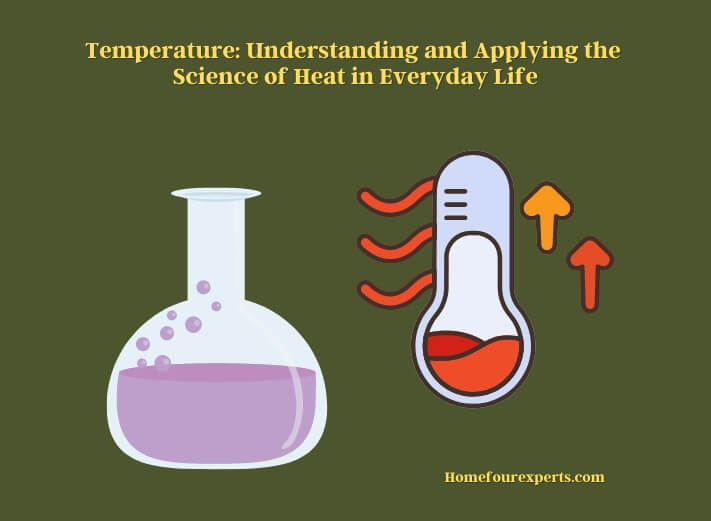Introduction to Temperature
Temperature is an essential aspect of our everyday lives. It influences our comfort, food, weather, and even our bodies. But have you ever wondered what temperature actually is? In this article, we’ll explore the science behind temperature, different temperature scales, how it’s measured, and its impact on our daily lives.

The Science Behind Temperature
Temperature is a measure of the average kinetic energy of the particles in a substance. In other words, it tells us how fast the atoms or molecules in an object are moving. The more energy they have, the faster they move and the higher the temperature.
Heat Transfer
Heat transfer occurs when energy moves from a hotter object to a colder one. There are three primary methods of heat transfer: conduction, convection, and radiation. Conduction occurs when heat is transferred through direct contact between objects. Convection is the transfer of heat through fluids like air or water, while radiation is the transfer of heat through electromagnetic waves.
Thermodynamics
Thermodynamics is the branch of physics that studies the relationship between heat and other forms of energy. It revolves around four key laws that govern the behavior of energy in systems, and it plays a crucial role in understanding how temperature influences our world.
Temperature Scales
There are three main temperature scales used worldwide: Celsius, Fahrenheit, and Kelvin.
Celsius
The Celsius scale, named after Swedish astronomer Anders Celsius, is the most widely used temperature scale globally. It defines the freezing point of water as 0°C and the boiling point as 100°C at sea level.
Fahrenheit
The Fahrenheit scale, developed by German physicist Daniel Fahrenheit, is primarily used in the United States. It sets the freezing point of water at 32°F and the boiling point at 212°F.
Kelvin
The Kelvin scale, named after Scottish physicist Lord Kelvin, is the standard unit of temperature in the scientific community. It has the same increments as the Celsius scale, but it starts at absolute zero (0 K), the lowest possible temperature at which all molecular motion ceases. Absolute zero is equal to -273.15°C or -459.67°F.
Measuring Temperature
Various tools and techniques are used to measure temperature, depending on the context and the level of accuracy required.
Thermometers
The most common instrument for measuring temperature is the thermometer. There are different types of thermometers, such as liquid-in-glass thermometers, which rely on the expansion and contraction of a liquid (usually mercury or alcohol) inside a glass tube to indicate temperature changes.
Infrared Thermometers
Infrared thermometers, also known as non-contact thermometers or temperature guns, measure temperature by detecting the infrared radiation emitted by an object. This allows for temperature measurement from a distance, making it useful in situations where direct contact is not possible or desirable.
Temperature in Everyday Life
Temperature has a significant impact on various aspects of our daily lives, including cooking, climate, and our own body temperature.
Cooking
Temperature is crucial in cooking, as it determines how quickly and effectively food is cooked. Different foods require different temperatures for optimal results, and precise temperature control can significantly impact the taste and texture of a dish.
Climate and Weather
Temperature greatly affects the Earth’s climate and weather patterns. It drives the movement of air masses, which in turn creates weather phenomena like storms, cold fronts, and heatwaves. Moreover, long-term changes in temperature, such as global warming, can lead to significant environmental consequences.
Human Body Temperature
Our bodies maintain a constant internal temperature of around 37°C (98.6°F) to ensure optimal functioning of our organs and systems. When we’re exposed to extreme temperatures, our bodies use various mechanisms like sweating, shivering, and changes in blood flow to maintain this optimal temperature.
Conclusion
Temperature is an essential aspect of our lives, affecting everything from the weather to our bodies. Understanding the science behind temperature, how it’s measured, and its impact on various aspects of our lives helps us better navigate our world and make informed decisions. Whether it’s choosing the right temperature to cook a meal or understanding the implications of climate change, temperature plays a vital role in our everyday lives.
FAQs
What is the difference between heat and temperature?
Heat is a form of energy, while temperature is a measure of the average kinetic energy of the particles in a substance. Heat can be transferred between objects, while temperature is a property of the substance itself.
Why does it feel colder when it’s windy?
The wind causes a phenomenon called wind chill, where it feels colder than the actual air temperature. This occurs because the wind increases the rate of heat loss from our bodies, making us feel colder.
How do animals adapt to extreme temperatures?
Animals have various adaptations to cope with extreme temperatures. For example, polar bears have thick fur and a layer of fat to insulate them from the cold, while desert animals like camels can store water and have unique cooling mechanisms to survive high temperatures.
What is thermal expansion?
Thermal expansion is the increase in volume of a substance as its temperature rises. This occurs because the particles in the substance move faster and occupy more space when they have more kinetic energy.
What is the role of temperature in climate change?
Rising global temperatures, primarily caused by the release of greenhouse gases, are the main driver of climate change. As temperatures increase, it leads to a variety of environmental consequences, such as more frequent and severe weather events, melting ice caps, and rising sea levels.
About This Writer

Hi, I am responsible for the 'Homeowners Power Solutions' category. My name is Liam Jaxon and a licensed technician with 7 years of experience in vehicle batteries, electrical gadgets, and home appliances. My working experience in different residential & light commercial electrical sectors and the automobile industry helped to acquire vast knowledge in this industry.